Review and images by JimoAi; edited by bmathison1972
To close off my Yujin Saltwater Fish in Colour Part 1 reviews (see the first parts here and here), I am hereby reviewing the last 3 of the fish; they’re all the secret and chase pieces. Instead of going by numerical numbers, I’ll start from the weakest to the best (in my opinion).
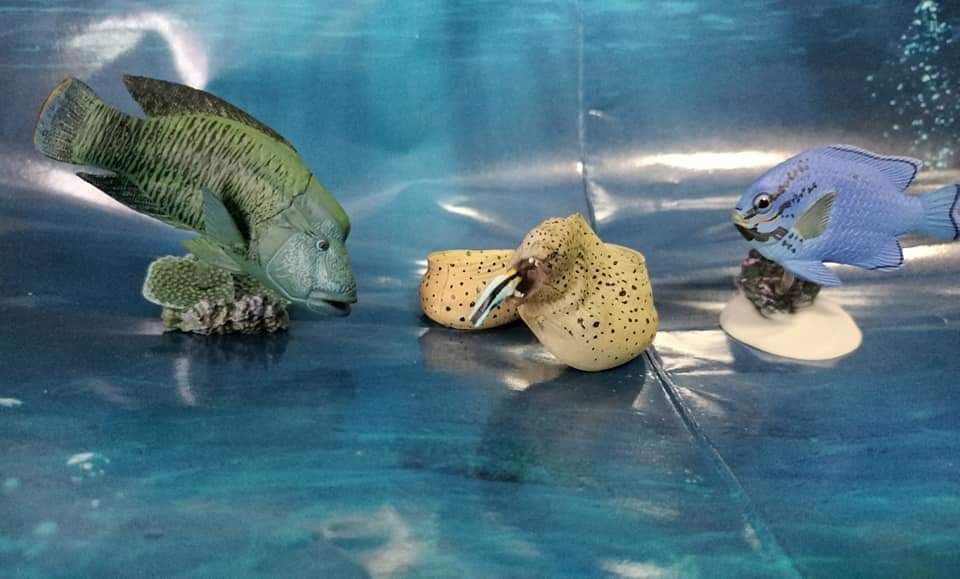
Blue Damselfish (Chrysiptera cyanea)
- Size of figure: 4.8 cm
- Size of the animal: 4-8.5 cm
- Scale: 1:0.83-1:7
- Color: electric blue main body; lighter blue eye and gradients on the fins and parts of the face; black speckled markings around the face and black outlines on the boarder of the dorsal, caudal, and anal fins; transparent pectoral fins
- Diet: omnivorous
- Species frequency of being made into toy form: very rare
- Base: sand with live rock
Notes: This figure is pretty lackluster. While it’s not terrible, I feel this figure is a missed opportunity, as that either due to time constraints or cost cutting, it shares the sculpt with the whitetail dascyllus from the set, despite being from a different genus. The real blue damselfish would be more slender in comparison, with males having a yellow tail and a yellow belly. I feel that something like a sailfin tang repaint of the yellow tang or a black-and-white repaint of the clownfish would be better secrets if they had to repaint a figure to be a secret. Or maybe even an entirely new sculpt like an Emperor or Regal angelfish? To me, this figure feels like the weakest of the set and it’s the last figure in the lineup too! If you’re after a a proper figure of the species, consider the Yowie figure, which has the proper body shape.
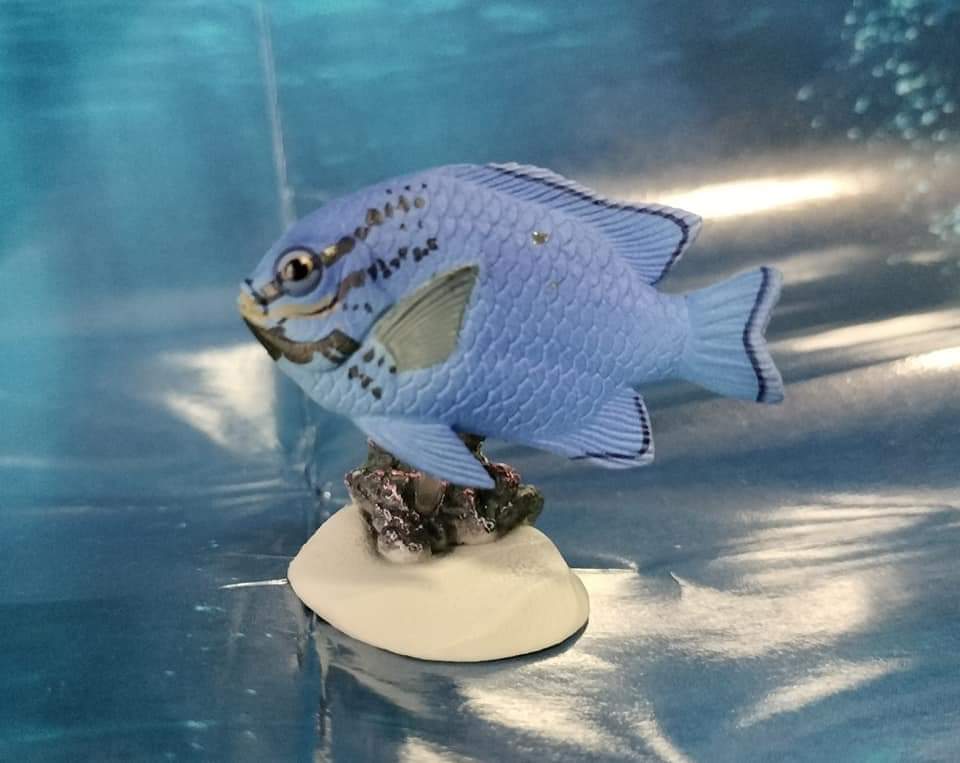
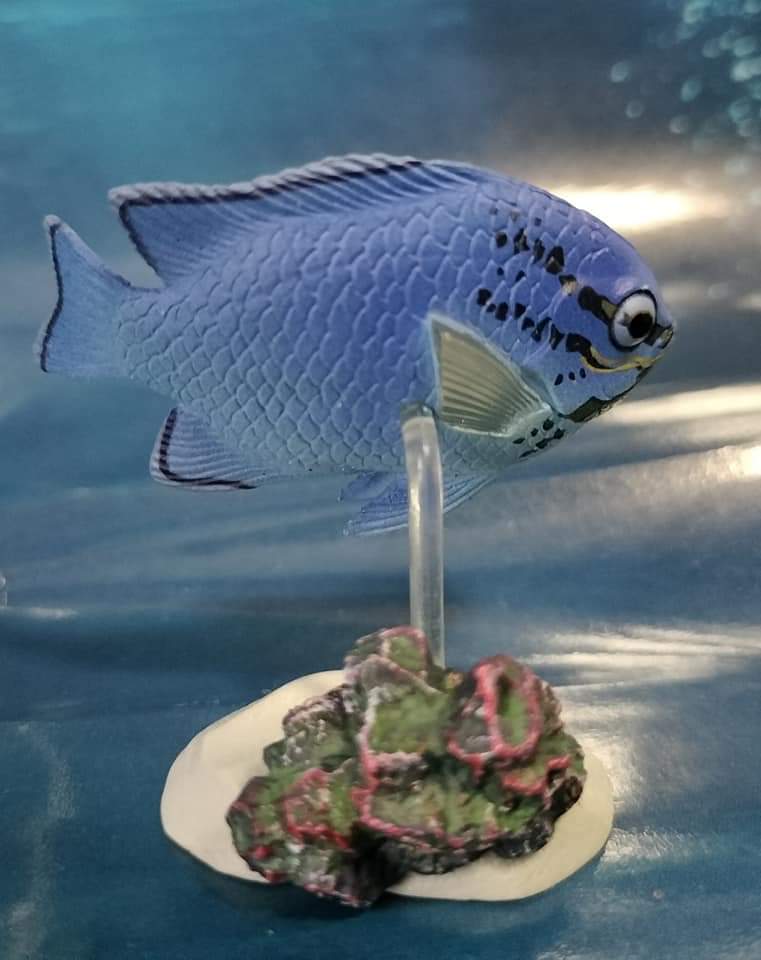
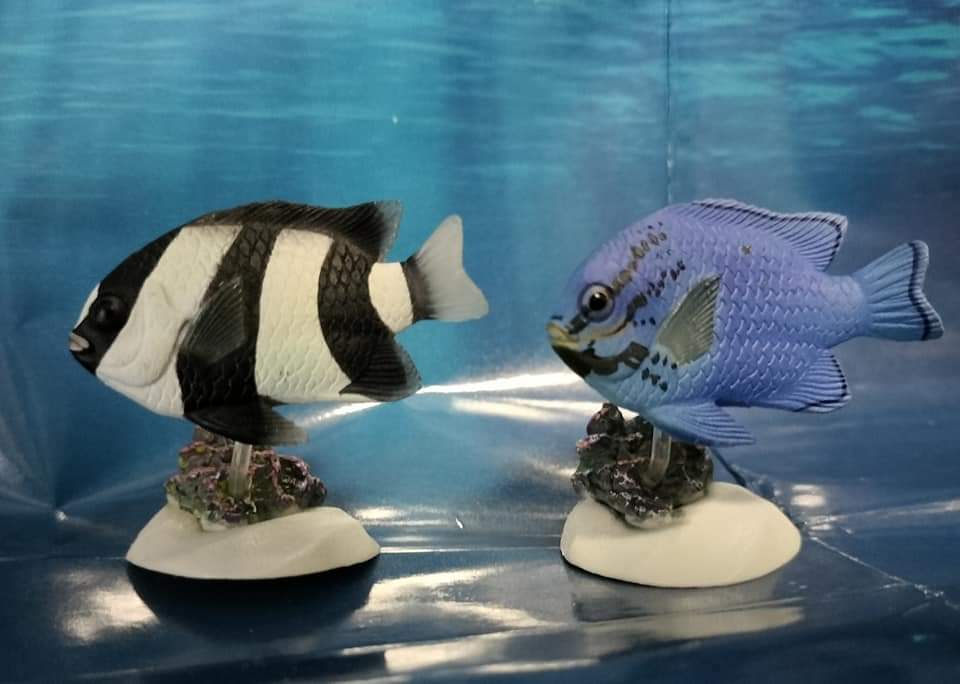
Napoleon Wrasse (Cheilinus undulatus)
- Size of figure: 7.5 cm
- Size of the animal: 50-229 cm for a mature specimen
- Scale: 1:7-1:30
- Color: forest green main body; black-striped markings on the body and fins; splash of light blue on the dorsal, caudal, anal, and tips of the pectoral fins; black and yellow edge on the caudal fin; turquoise face with sky blue markings and darker blue lips; very dark brown eyes
- Species frequency of being made into toy form: rare
- Case: Plate coral
Notes: Now this is a secret figure! Probably the most sophisticatedly-painted figure of the set, and it has a unique base! The figure has nice large-scale details and a lateral line sculpted, but that seems to be almost obscured by how colorful the figure is! This figure represents a mature male with the prominent hump on the head and the thick lips. The figure is posed looking down as if it’s foraging for prey in the reef. There is a seam between the body and the head, as this figures requires minor assembly due to how big it is. It’s probably the second largest figure in the set behind the last figure of the set, fitting for one of the largest reef fishes (not counting sharks and rays)! This is amongst the best figures of the species, along with 2 Kaiyodo versions and those by Aquameridian and Kitan Club. The Bandai Animals of Australia version and the Ikimon figure also feature plate coral bases, which seems to be a trend for Napoleon wrasse figures. Due to its size, it does scale well with many marine megafauna figures like the Schleich great white shark and the Kaiyodo great barracuda.

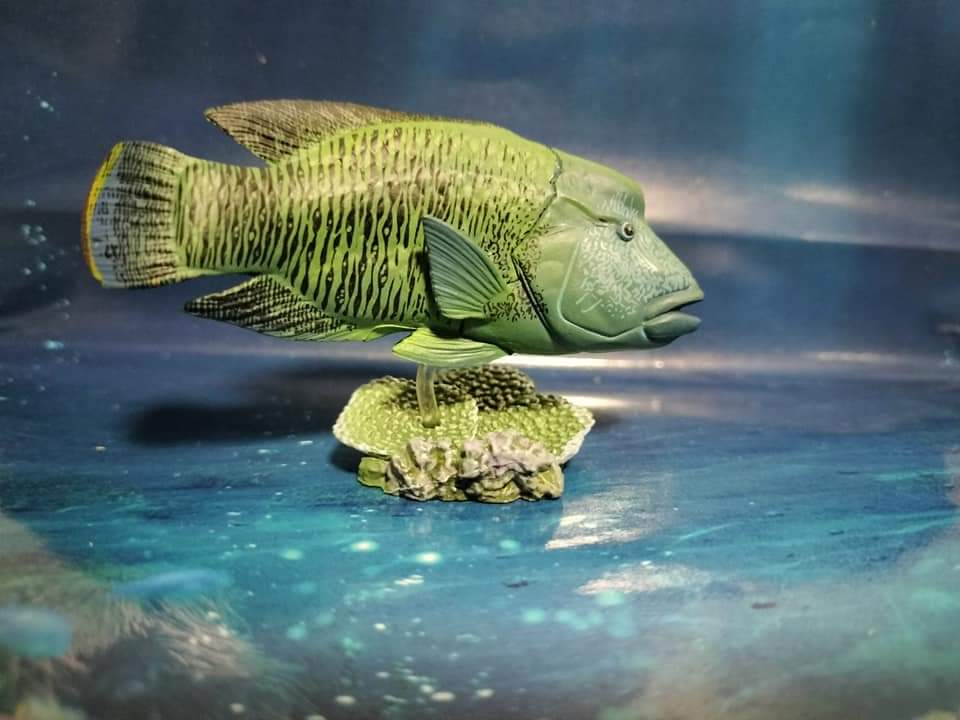
Giant/Spotted Moray Eel with Bluestreak Cleaner Wrasse (Gymnothorax javanicus/isingteena with Labroides dimidiatus)
- Size of figures: roughly 14 cm for the eel; 1.4 cm for the wrasse
- Size of the animals: 120-300 cm for the eel; 20 cm for the wrasse
- Scales: 1:8.5-1:22 for the eel; 1:14 for the wrasse
- Colors: Eel: sandy brown main body with gray underbelly; black spots; white eyes with black pupils; white teeth. Wrasse: white main body; yellow head, pectoral, and pelvic fins; baby blue on the second half of the body; black line across the face until the tail; brown eyes and black pupils
- Diet: Eels: predators on fish and occasionall crustaceans. Wrasse: parasites and dead tissues on host fish
- Species frequency of being made into toy form: Eel: very rare (unique as a sculpt). Wrasse: very rare
- Base: none
Notes: This is one of three instances of symbiotic relationships in reef fish figures, with the anemonefish/sea anemone and shrimp/gobies pairings also made. It is the largest figure in the set and being a serpentine animal, is posed curled to save space in the gashapon packaging, and thus not needing a base. Despite being the least colorful in the set, this figure is the best figure in the set for displaying the unique behavior of the wrasse cleaning the eel. Fine wrinkles are sculpted amongst the neck and where the eel bends. The spiracle holes are present, although they are not painted. Now for the elephant in the room: the confusing identity of the figure. The figure is marketed as G. javanicus. However, the main body color is too pale and instead resembles more that of G. isingteena, albiet the spots are way too few. Whilst doing research on G. javanicus, I’ve discovered that juveniles have lighter colors, similar to how this figure is painted. However, the body proportions of this figure resembles a mature adult, especially with how beefy the eel is and having the eye being smaller in proportion to the rest of the body. My best guess that the eel is based on one very specific individual as opposed to representing the entire species as a whole, and it’s honestly up to you what you want this eel to represent in your collection. I have done a repaint on another copy of this figure to resemble a typical adult specimen (fourth pic, below). On the other hand, the wrasse is spot on despite being super tiny. The left side of the wrasse is undetailed but I think it’s forgivable since it’s part of the eel and the small size of the figure. The moray eel has been made by Kaiyodo and Toy Spirits, with the latter sharing sculpts with similar species. Another thing to note is that this eel scales well with many predatory reef fish figures like the Papo spotted eagle ray, Safari Ltd. whitetip reef shark, and Safari Ltd. Goliath grouper.

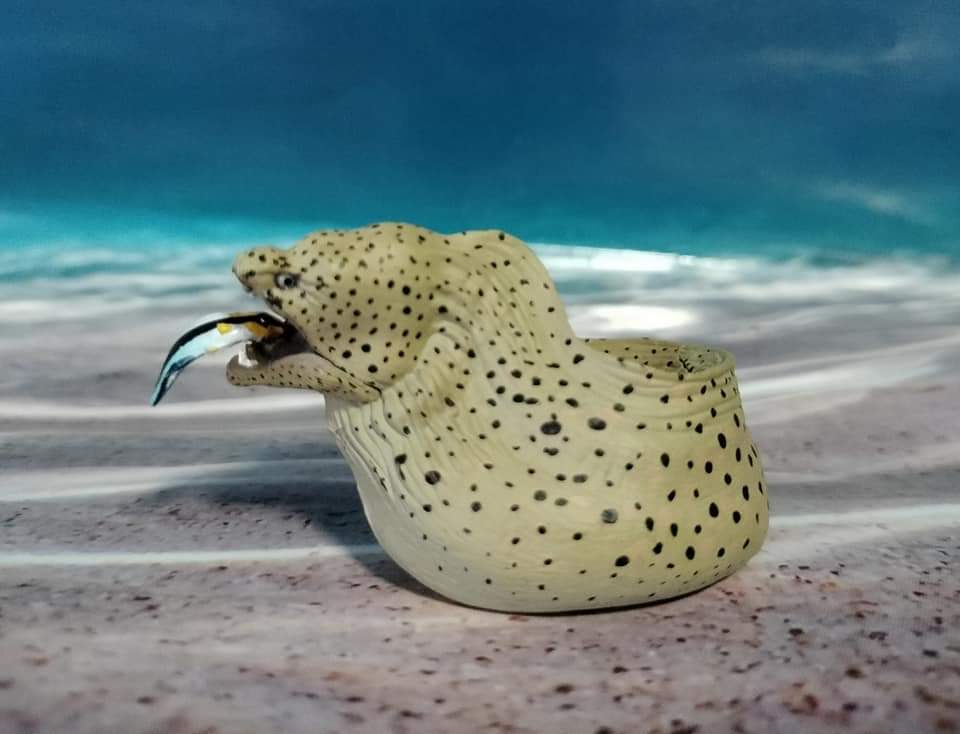
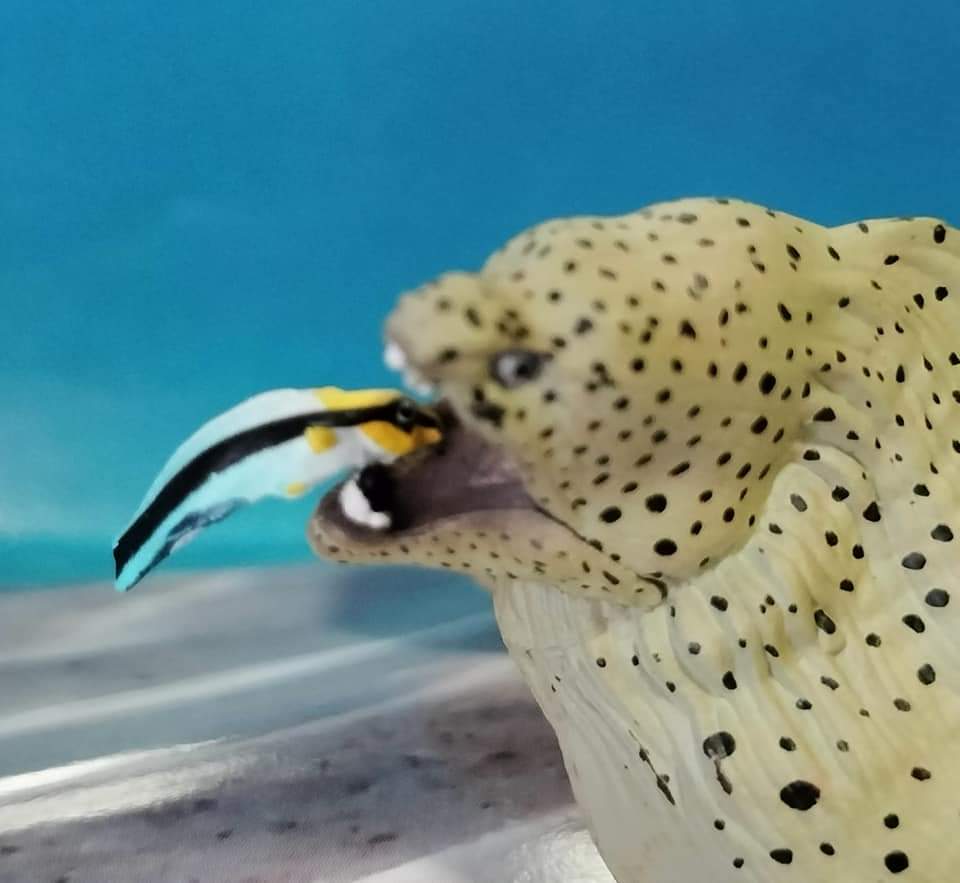
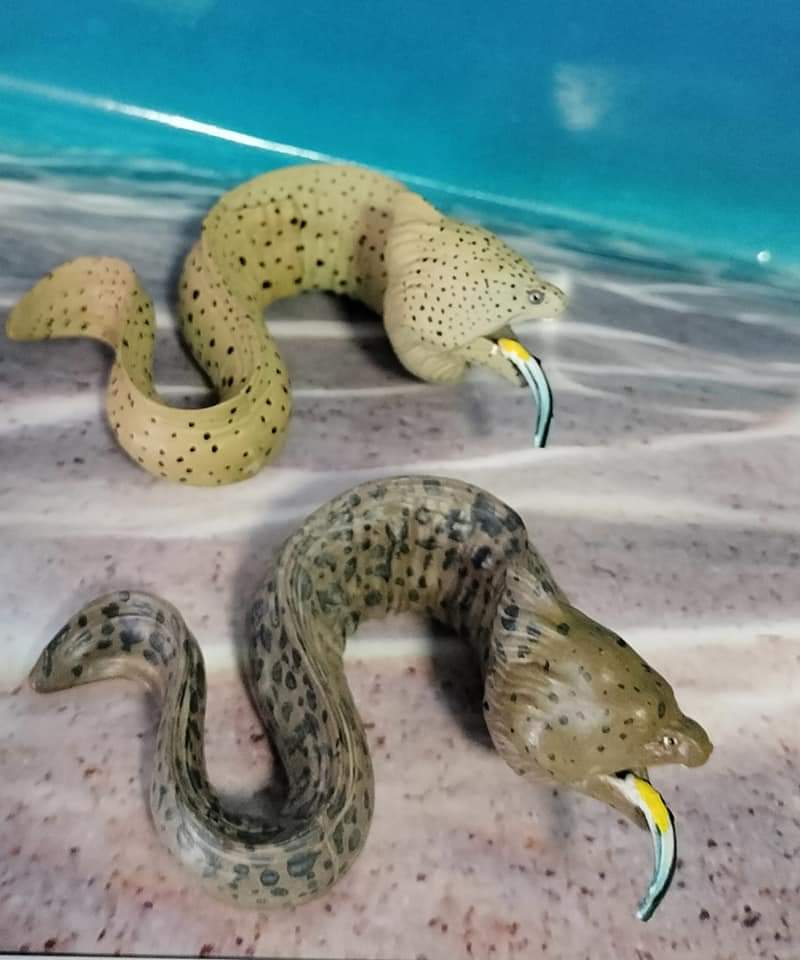
Overall, the selection of chase figures makes chasing them all the more worth it, with how well they’re executed and the unique poses the figures are in. I can let the damselfish slide, especially with how good the wrasse(s) and the eel are. Being older sets, they have been retired for a while, so your best bet is eBay or Japanese shopping sites, but being secret figures, they command a heftier price tag (roughly 30-80 USD range) in the after market (even though they are often cheaper than the porcupinefish and coral trout when sold separately). In set 2, there’s a shoal of striped eeltail catfish chase figures which I felt should’ve been part of this set, as they are the only catfish species known to inhabit coral reefs, but I guess they’ve stuck it to the second set for variety. It’s been a long ride and I’m happy to say I’ll be closing all Yujin Saltwater Fish reviews for now.
Disclaimer: links to Ebay and Amazon on the AnimalToyBlog are affiliate links, so we make a small commission if you use them. Thanks for supporting us!




Thank you for rounding out this amazing set!
I have most of them (I have replaced a few). I knew the blue damselfish was a repaint of the dascyllus, but I didn’t know the proportions were that off. I think I might hunt down the Yowie version to replace it!!!
one of the notable times a western brand beats out on a Japanese release!